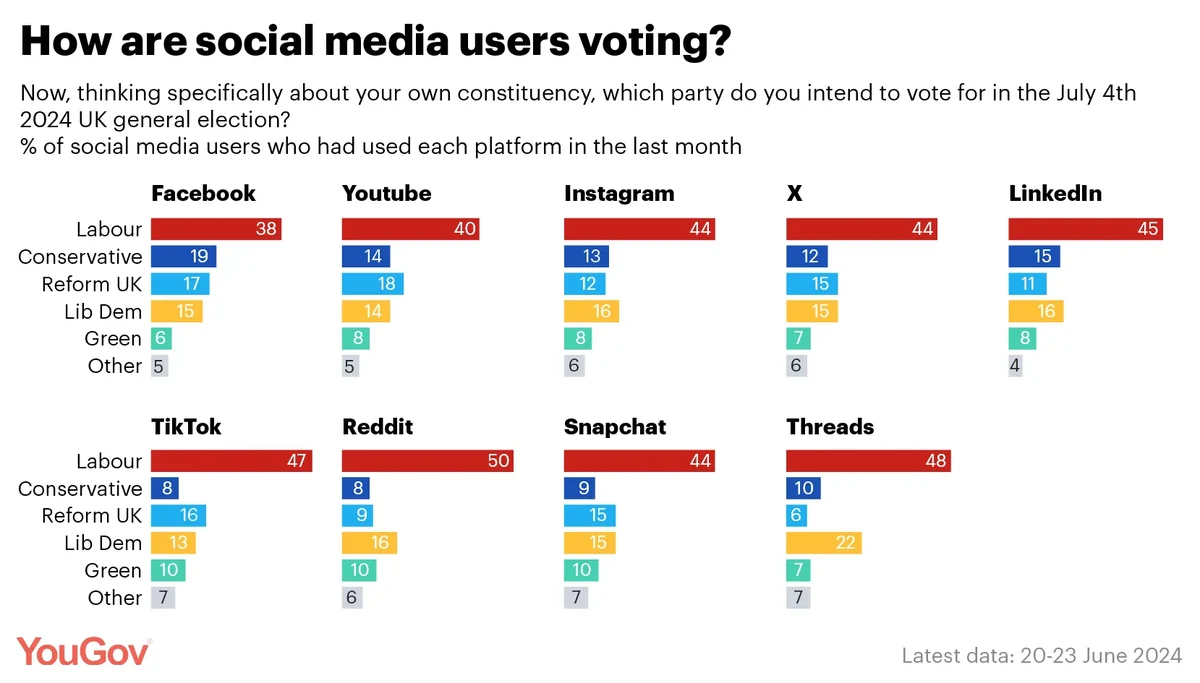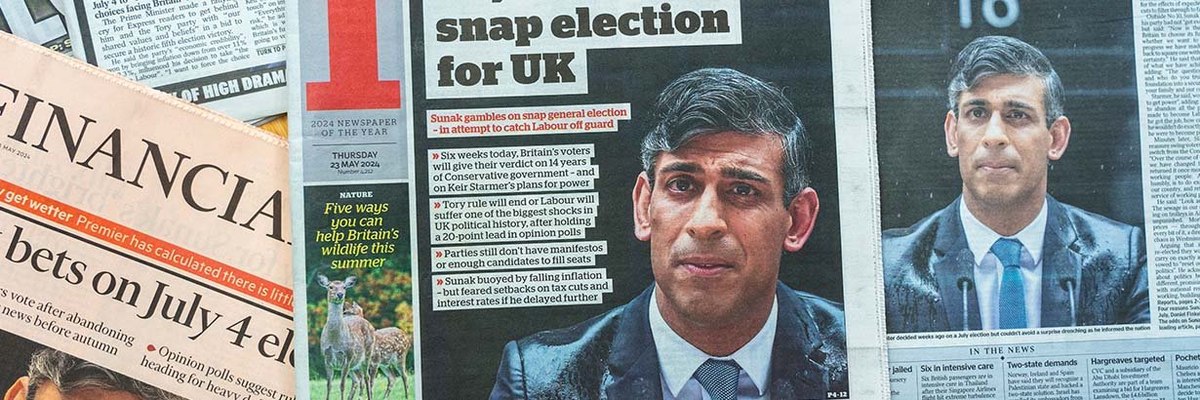TikTok has reached a third of young Britons with election content
With the election date in sight, a new YouGov study examines how Britons have been getting their news over the course of the campaign so far.
The results show that overall, half of Britons say they have been following news about the election campaign very or fairly closely (50%).
Those planning to vote Labour, Lib Dem or Reform UK are particularly engaged, with 62-64% of each group saying they are closely following the news. By contrast, 54% of Greens and 48% of Tory voters say the same.
If you want to see which news stories of the campaign have cut through with voters, our new AI-powered language model has been tracking the top stories – you can see the latest results here.
But where are Britons getting their news from?
TV is the most common single source of news for Britons
There is only one source that a majority of Britons say they get news from: TV (58%). After this there is a significant drop to a cluster of sources: social media (43%), newspaper websites (42%) and radio (42%). A further 33% also say they get news from a news website not associated with a newspaper.
Only 14% still get news from printed newspapers, while almost as many are embracing the newer medium of podcasts (13%).
While TV might be the most common single source of news, if we merge all of the digital news formats we get 77% of Britons who get their news online in some way. An equivalent merging of ‘broadcast’ formats (TV and radio) finds 70% of Britons in total getting their news from the airwaves.
How do different voting groups get their news?
There are noticeable differences between voting groups on where they get their news. While TV is still the most common source for most of those voting for major national parties, Conservative voters are particularly like to get their news from the telly (70%). They are also more likely than other voting groups to get their news from printed newspapers (26%).
Green voters are the only major voting group for whom TV is not the most common source of news. Instead, most Greens get news from social media (55%), while being just as likely to get it from a newspaper website (48%) as they are the TV (46%).
Labour voters also have a higher tendency to get news from social media (51%), while Conservative voters are significantly less likely to do so (27%).
Greens, Labour and Lib Dem voters are also typically more likely to get news from newspaper websites (47-51%), with Reform UK voters being least likely to do so (37%).
Labour and Lib Dem voters are also more likely to get news from non-newspaper news websites (39-41%).
Radio news is most likely to reach Lib Dem (49%) and Conservative voters (48%), and least likely to reach the Greens (35%). Greens are instead more likely to be training their ears on podcasts for their news (22%), as are 19% of Lib Dem and Labour voters, but only 8-11% of Tory and Reform UK voters.
Greens are also the most likely to get their news from email newsletters (14%) and blogs not associated with major news agencies (11%).
Many of these differences will be a factor of age, which has been the key factor in which party people vote for since the 2017 general election.
The older Britons are, the more likely they are to get news from traditional methods, particularly TV: 74% of the over-65s do so, compared to 45% of 18-24 year olds. They are also more likely to get news from printed newspapers and radio.
By contrast, young Britons are far more likely to get their news from digital sources, especially social media, with 72% of 18-24 year olds doing so versus 19% of the over 65s. Overall, 90% of the youngest Britons get news online compared to only 60% of the oldest Britons.
What social media platforms are voters using?
Britons are by far the most likely to have used Facebook in the last 30 days, with two thirds (69%) having logged on to the platform. Most have also been on YouTube (56%) while almost half have been on Instagram (46%).
After this, figures fall to 29% for X, formerly known as Twitter, while one in five have used LinkedIn (20%) and TikTok (20%).
Again, different voting groups use different social media platforms at different rates.
Facebook is the top platform for all major voting groups, ranging from 63% among Green voters to 74% among Lib Dems.
YouTube is similarly popular across most voting groups (60-66%) except the Conservatives, of whom only 42% have used the platform in the last 30 days.
Labour, Green and Lib Dem voters are noticeably more likely to have used Instagram (54-59%) than their Conservative and Reform UK-voting counterparts (31-33%).
Labour voters are also particularly likely to have been on X (39%), compared to 34% of Lib Dem and Green voters, 29% of Reform UK voters and 21% of Tories.
When it comes to TikTok, Greens are the most likely to have used the platform in the last 30 days, at 29%. This compares to 24% of Labour voters, 18% of Lib Dem and Reform UK voters, and only 8% of Conservative voters.
Again, plays a role in what social media networks people have been accessing. While for the three older age groups Facebook is the most widely-used network (69-72%), among 18-24 year olds it only ranks joint-fourth at 55% - tied with TikTok. YouTube and Instagram top the list among this youngest age group at 81% and 78% respectively, while a further 60% are using Snapchat and 50% X.
How many people have seen election-related content on social media?
X and TikTok users are the most likely to have been exposed to election-related content: 60% of those using the former social network and 52% of those using the latter say they have seen election content in the last 30 days.
After this there is a steep drop to a cluster of Facebook (34% of users have seen election content), Instagram (32%), Reddit (29%), YouTube (28%) and Threads (28%). Those on LinkedIn (13%) and Snapchat (8%) are noticeably less likely to report seeing election-related content.
While X and TikTok may top the list, the nature of those encounters with election content are different – 23% of X users have actively sought out election content on the platform to read or watch, compared to only 8% of TikTok users.
Similar numbers say that the election content they have seen has been incidental (29% on X and 33% on TikTok), while one in five (18-19%) say they have encountered political advertising.
An identical number of Facebook users also report having seen political advertising (18%), which in that case is the most common way users encountered election content on the platform.
Many of these platforms are only used by a minority of Britons, however. If we display these figures as a proportion of the entire population, as opposed to just the user base, we can see that the most common way people have encountered election content is on Facebook, at 23%.
X still comes second overall, with 17% of all Britons having seen election content on the platform, with similar numbers having consumed it on YouTube (16%) and Instagram (15%). One in ten Britons (10%) have watched election content on TikTok.
There are dramatic differences between age groups, however. Among 18-24 year olds, more than four in ten (44%) have seen election content on Instagram in the last 30 days, making it the best platform to have reached that group. Another 36% have seen TikTok election content, a third (33%) have seen it on YouTube and another 30% on X.
By contrast, for older age groups it is Facebook which is the most common way that political content has reached people. This is at noticeably lower rates, however, at 25-27% of those aged between 25 and 64, and only 19% of the over-65s.
When it comes to voting groups, Facebook is most likely to have reached Conservative, Labour, Lib Dem and Reform UK voters with election content (20% for the first group, 29-30% for the latter three).
Green voters’ eyeballs are, instead, more likely to have been reached with content on Instagram (27%) – one in five Labour and Lib Dem voters (20-21%) have likewise been reached via that platform.
Similar numbers of Labour, Lib Dem, Green and Reform UK voters have been reached by content on X (21-26%), but considerably fewer Conservative voters have (11%).
One in seven Green and Labour voters have been reached by TikTok content (15-16%).
How are social media users voting?
Looking at voting intention by social media platform shows that Labour are far ahead in each case – hardly surprising given the size of their lead in the national polls. Their strongest showing is on Reddit, where 50% of those who have used the social network in the last month say they will back Keir Starmer’s party, and their weakest performance is on Facebook (38%).

Facebook is, coincidentally, the Conservatives’ best platform, although at 19% only half as many will back Rishi Sunak’s party as their main rivals. It is also the only platform on which the Tories place second overall. You are least likely to find a Tory voter on Reddit or TikTok (8% in both cases).
Threads – Meta’s X/Twitter competitor – is the most likely to be voting Lib Dem (22%), while YouTube is top for Reform UK voters (18%) and the Greens’ highest vote share is on TikTok, Reddit and Snapchat (10% each).
What do you think about the parties' use of social media, the election campaign, and everything else? Have your say, join the YouGov panel, and get paid to share your thoughts. Sign up here
Photo: Getty











